Fleurs du Mal Magazine


Or see the index
A timeless, visionary collection of poems from one of China’s most acclaimed poets-now available in English for the first time in a generation and featuring a foreword by his son, contemporary artist and activist Ai Weiwei
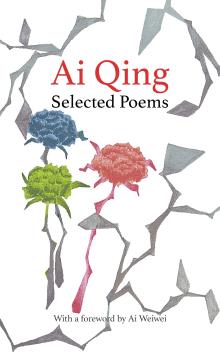 One of the most influential poets in Chinese history, Ai Qing is mostly unknown to Western readers, but his work has shaped the nature of poetry in China for decades. Born between the fall of imperial Manchurian rule and the establishment of the Communist People’s Republic, Ai Qing was at one time an intimate of Mao Zedong.
One of the most influential poets in Chinese history, Ai Qing is mostly unknown to Western readers, but his work has shaped the nature of poetry in China for decades. Born between the fall of imperial Manchurian rule and the establishment of the Communist People’s Republic, Ai Qing was at one time an intimate of Mao Zedong.
He would eventually fall out with the leader and be sentenced to hard labor during the Cultural Revolution, when he was exiled to the remote part of the country known as “Little Siberia” with his family, including his son, Ai Weiwei.
In his work, Ai Qing tells the story of a China convulsing in change, leaving behind a legacy of feudalism and imperialism but uncertain what the future will hold. Breaking with traditional forms of Chinese poetry, Ai Qing innovatively adapted free verse, writing with a simple sincerity in clear lines that could be understood by everyday readers.
Selected Poems of Ai Qing is an extraordinary collection that traces the powerful inner life of this influential poet who crafted poems of protest, who longed for a newer, happier age, and who wrote with a profound lyricism that reaches deep into the heart of the reader.
Selected Poems by Ai Qing (Author),
Ai Weiwei (Introduction), Robert Dorsett (Translator)
Ai Qing is regarded as one of the finest modern Chinese poets, whose free verse was influential in the development of new poetry in China.
Ai Weiwei is one of the world’s most important living artists. Born in 1957, he lives in Cambridge, UK.
Allan H. Barr is the author of a study in Chinese of a literary inquisition in the early Qing dynasty, Jiangnan yijie: Qing ren bixia de Zhuangshi shi’an, and the translator of several books by contemporary Chinese authors, including Yu Hua’s China in Ten Words and Han Han’s This Generation. He teaches Chinese at Pomona College in California.
# new poetry
Selected Poems by Ai Qing (Author),
Ai Weiwei (Introduction),
Robert Dorsett (Translator)
Publisher: Vintage Classics
2 Nov. 2021
Language: English
Hardcover
128 pages
ISBN-10: 1784877662
ISBN-13: 978-1784877668
£12.99
• fleursdumal.nl magazine
More in: #Editors Choice Archiv, #Modern Poetry Archive, - Book News, - Bookstores, Ai Weiwei, Archive A-B, Archive A-B
Dictatuur, schendingen van mensenrechten, milieuvervuiling, verdronken vluchtelingen: dit zijn niet alleen de urgentste kwesties in de wereldpolitiek, maar ook de thema’s in het werk van Ai Weiwei.
 Met zijn enorm veelzijdige creativiteit en maatschappelijke engagement zet hij als een van de beroemdste en grootste kunstenaars van onze tijd vrijwel alles op het spel: hij werd gearresteerd, zijn paspoort werd ingenomen, en afgelopen zomer nog sloopten de Chinese autoriteiten zonder waarschuwing zijn studio in Beijing.
Met zijn enorm veelzijdige creativiteit en maatschappelijke engagement zet hij als een van de beroemdste en grootste kunstenaars van onze tijd vrijwel alles op het spel: hij werd gearresteerd, zijn paspoort werd ingenomen, en afgelopen zomer nog sloopten de Chinese autoriteiten zonder waarschuwing zijn studio in Beijing.
Als geen ander kan Ai Weiwei dus vertellen over de verantwoordelijkheid van de kunstenaar. Wat vermag de kunst in een tijd waarin dissidenten worden opgesloten en journalisten zonder pardon het land uit worden gezet?
Hoe ver mag de kunstenaar gaan?
Hoe ver moét hij gaan?
Hoor het bij de Nexus-lezing 2019, The Responsibilities of an Artist.
The Responsibilities of an Artist
Nexus-lezing Ai Weiwei
25 mei 2019
14.30 – 17.30
Aula VU Amsterdamhttps://nexus-instituut.nl/
# meer informatie op website nexus-instituut
• fleursdumal.nl magazine
More in: Ai Weiwei, Art & Literature News, AUDIO, CINEMA, RADIO & TV, DICTIONARY OF IDEAS, Nexus Instituut
_____________________________________________________________________________
August 7, 2018
NEW YORK – The unannounced demolition of Chinese artist Ai Weiwei’s studio in Beijing is symptomatic of a larger attack on human rights and artistic expression in China, said PEN America today.
On August 6, Artist and activist Ai Weiwei announced on social media that authorities had demolished his Beijing artist studio. Ai stated that he had received no advance notice prior to the demolition. Although several of his works were damaged in the studio’s demolition, the artist explained that he is more preoccupied with the effects of China’s “urban development” projects on artists and migrant populations, saying: “Since last year, a policy was enacted to clear out migrant workers from Beijing . . . Those who do not belong to the establishment, including artists, are always the first to be discriminated against and sacrificed.”
Within the past few years, artist colonies including Songzhuang and Caochangdi—the latter an arts district that Ai helped develop—have been targeted for eviction and demolition. Artists have cited both runaway economic development and political disfavor as rationales for authorities’ hostile attitudes. More broadly, an urban development policy conceived last year to push migrant workers out of Beijing has empowered local authorities to take unannounced action to demolish property, a policy that has led to thousands of migrant workers losing their homes.
“Regardless of the government’s motives, the unannounced demolition of an artist’s studio is a demonstration of a lack of appreciation or even acknowledgment for the role of the artist in society,” said Julie Trébault, Director of PEN America’s Artists at Risk Connection. “Around the world, artist studios and communes are spaces to be cherished, not discarded.”
PEN America leads the Artists at Risk Connection (ARC), a program dedicated to assisting imperiled artists and strengthening the network of organizations that support them. If you or someone you know is an artist at risk, contact ARC here.
PEN America stands at the intersection of literature and human rights to protect open expression in the United States and worldwide. They champion the freedom to write, recognizing the power of the word to transform the world. Their mission is to unite writers and their allies to celebrate creative expression and defend the liberties that make it possible.
www.pen.org
the freedom to write
fleursdumal.nl magazine
More in: Ai Weiwei, Art & Literature News, AUDIO, CINEMA, RADIO & TV, Exhibition Archive, FDM Art Gallery, MUSEUM OF PUBLIC PROTEST, REPRESSION OF WRITERS, JOURNALISTS & ARTISTS
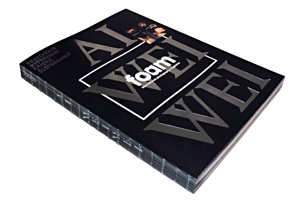 Foam Magazine #43: Ai Weiwei – Freedom of Expression under Surveillance
Foam Magazine #43: Ai Weiwei – Freedom of Expression under Surveillance
Foam is proud to launch the brand new and unique Foam Magazine, which was made in close collaboration with world-renowned Chinese contemporary artist and activist Ai Weiwei (1957, Beijing). Weiwei is guest editor for this issue that is entirely dedicated to the theme ‘Freedom of Expression under Surveillance’. Ai Weiwei himself is the central point of the magazine, as an artist under constant surveillance by the Chinese government. The magazine contains images he made while documenting his life by using Instagram and webcams, but also pays attention to Ai Weiwei’s constant endeavour to keep a sharp eye on the ones surveilling him.
 Freedom of Expression under Surveillance
Freedom of Expression under Surveillance
Containing an interview with, and quotes by the artist Foam Magazine #43 is divided into four parts: ‘Sousveillance”, ‘Self Surveillance’, ‘Urban Surveillance’ and ‘Art and Surveillance’. It reports on the way the artist worked the last few years. Instagram and Twitter became the means by which Ai Weiwei shared virtually every aspect of his life with a steadily growing multitude of followers all over the world. Part of the issue shows a selection of the endless stream of images posted on Instagram by Ai Weiwei. In another part Weiwei shares stills from the ‘Weiweicam’ he directed at himself 24/7. Foam Magazine #43 documents crucial and highly eventful period in the life of one of the most important artists of our age.
About Ai Weiwei
Ai Weiwei is an influential Chinese contemporary artist and activist. As a political activist, he has been openly criticizing the Chinese Government’s stance on democracy and human rights. In 2011, following his arrest at Beijing Capital International Airport he was held for 81 days without any official charges being filed. Recently he had his passport returned to him and was given the opportunity to travel abroad. Among art works by Ai Weiwei are Fairytale (2007), produced for Documenta 12, and Sunflower Seeds, an installation in London’s Tate Modern in 2010. A major solo exhibition of his work is currently on show at the Royal Academy of Arts, London.
ISBN 9789491727825
Published December 2015
288 pages + 4 cover pages front + back
Printed on selected specialized paper
Swiss bound
300x230x25 mm
€22,50
# More information: www.foam.org
Photo Anton K. (FdM): Protest in Berlin, Linienstrasse, 2011
fleursdumal.nl magazine
More in: - Book News, Ai Weiwei, Art & Literature News, Art Criticism, MUSEUM OF PUBLIC PROTEST, Photography, REPRESSION OF WRITERS, JOURNALISTS & ARTISTS
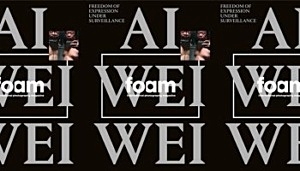 Ai Weiwei – #SafePassage
Ai Weiwei – #SafePassage
16 september – 7 december 2016
Dit najaar presenteert Foam #SafePassage, een tentoonstelling van het werk van de Chinese kunstenaar en activist Ai Weiwei (1957, Beijing). Omdat de kunstenaar zelf lange tijd constant in de gaten werd gehouden door de Chinese overheid, ervaart hij een persoonlijke verbondenheid met de groeiende stroom vluchtelingen die Europa probeert binnen te komen.
Sinds zijn eerste bezoek aan het Griekse eiland Lesbos, in december 2015, bezocht Ai Weiwei met zijn team tal van vluchtelingenkampen rond de Middellandse Zee, onder andere in Syrië, Turkije, Israël en Frankrijk. De tentoonstelling gaat over de strijd tussen het individu en de machtsstructuren die de samenleving domineren. Centraal staan zowel de ervaringen die Ai Weiwei ertoe hebben gebracht zijn vaderland te verlaten, als die van honderdduizenden vluchtelingen en migranten die hun leven blijven riskeren om Europa te bereiken, vaak met als enige resultaat dat zij voor gesloten grenzen komen te staan.
 Ai Weiwei
Ai Weiwei
Ai Weiwei, die als belangrijkste Chinese kunstenaar, ontwerper en curator van dit moment wordt beschouwd, is een vooraanstaand sociaal en cultureel commentator. Hij is een voorvechter van mensenrechten en democratie en levert onvermoeibaar en ongezouten kritiek op het politieke stelsel in China. Hij heeft herhaaldelijk onderzoek gedaan naar overheidscorruptie en doofpot affaires, waardoor hij een voortdurende doorn in het oog is van de Chinese autoriteiten. Na zijn arrestatie op de internationale luchthaven van Beijing in 2011 werd hij 81 dagen lang in het geheim gevangen gehouden, zonder dat er ooit officieel een aanklacht tegen hem was ingediend. Tijdens zijn gevangenschap werd hij continu verhoord en 24 uur per dag geobserveerd. Hij verkeerde in het gezelschap van twee bewakers die nooit van zijn zijde weken, zelfs niet als hij naar het toilet ging of sliep. Na zijn vrijlating werd zijn paspoort in beslag genomen en werd hij gedwongen om in te China blijven, waar de autoriteiten hem nauwlettend in de gaten bleven houden.
Tijdens de continue bewaking trachtte Ai Weiwei de situatie zoveel mogelijk in eigen hand te houden en zich op allerlei manieren te onttrekken aan de onophoudelijke inbreuken op zijn privacy. Hij startte een reeks experimenten, variërend van een livestream van zijn dagelijks leven via vier webcams in zijn atelier die wereldwijd kon worden bekeken op de website weiweicam.com, tot het bijhouden van een blog – totdat de overheid ingreep en hem beide mogelijkheden ontnam. Foam Magazine #43, dat in december 2015 verscheen, was volledig gewijd aan het thema ‘Freedom of Expression under Surveillance’ (‘vrijheid van expressie onder toezicht’). Ai Weiwei, die zelf als gastredacteur fungeerde en centraal stond in dit nummer, deed daarin uitgebreid verslag van deze belangrijke en donkere periode in zijn leven.
Tentoonstelling
De tentoonstelling begint met werken die een afspiegeling vormen van de persoonlijke ervaringen van de kunstenaar terwijl hij onder voortdurend toezicht stond, zoals is beschreven in Foam Magazine #43. In 2015 kreeg Ai uiteindelijk zijn paspoort terug. Kort daarna vertrok hij naar Europa en vestigde zich in Berlijn, waar hij nu zijn atelier heeft. Nog altijd hanteert hij de strategie van ultieme zelfbewaking, in de vorm van een vrijwel continue stroom beelden die hij op Instagram plaatst. Zo kan iedereen met een internetverbinding hem van dag tot dag volgen. Sinds zijn eerste bezoek aan het Griekse eiland Lesbos, in december 2015, fungeren zijn Instagram-beelden als een soort realtime nieuwsblog van de reizen van zijn team langs de vluchtelingenkampen in het Middellandse Zeegebied. Als tweede deel van de tentoonstelling worden de wanden van Foam vol gehangen met duizenden foto’s die hij met zijn mobieltje heeft gemaakt. Het zijn overwegend spontane kiekjes die een goede indruk geven van de leefomstandigheden in de kampen. Deze immense collage geeft uitdrukking aan de talloze persoonlijke ontmoetingen die de kunstenaar had met mensen in de vluchtelingenkampen, waardoor de omvang van de crisis nog eens pijnlijk wordt benadrukt. Ai Weiwei’s beelden gaan vergezeld van een selectie uit zijn inmiddels legendarische serie marmeren beelden en een aantal van zijn video’s, waaronder: Chang’an Boulevard (2004), dat een beeld schetst van de weg die Beijing langs een oost-west as in tweeën deelt en On the Boat (2016), waarin we de kunstenaar zien op een achtergelaten boot midden op de oceaan.
Ai Weiwei is vooral bekend om zijn sculpturen en omvangrijke installaties, waarmee hij conceptueel een verbinding legt tussen traditionele cultuurgebonden ambachten en hedendaagse politieke boodschappen. Daarbij brengt hij een relatie tot stand tussen historische wortels, materialen en paradigma’s, en actuele vraagstukken in onze moderne maatschappij. Ai heeft overal ter wereld grote tentoonstellingen en paviljoens ingericht, maar daarnaast is hij ook architect, schrijver, cineast, filosoof en politiek activist. Weiwei’s activiteiten zijn onlosmakelijk verbonden met de staat van de hedendaagse Chinese kunst en maatschappij – of het nu gaat om samenwerking met het Zwitserse architectenbureau Herzog & de Meuron, dat hij met artistieke adviezen terzijde stond bij de bouw van het nationale stadion van Beijing voor de Olympische Spelen van 2008, of om zijn onderzoek naar corruptie bij de Chinese overheid.
De tentoonstelling wordt geopend op donderdag 15 september, vanaf half 6, in het bijzijn van de kunstenaar.
Foam
Keizersgracht 609
1017 DS Amsterdam
+31 20 5516500
foam.org
# Meer informatie: www.foam.org
Photo Anton K. (FdM): Protest in Berlin, Linienstrasse, 2011
fleursdumal.nl magazine
More in: Ai Weiwei, Anton K. Photos & Observations, Art & Literature News, Exhibition Archive, MUSEUM OF PUBLIC PROTEST, Photography, REPRESSION OF WRITERS, JOURNALISTS & ARTISTS, Sculpture
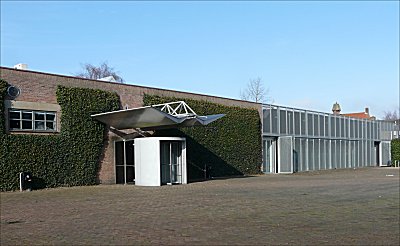
Museum De Pont Tilburg
De Witte Nacht
donderdagavond@depont voor één keer op zaterdag!
zaterdag 23 juni 2012, 17.00 – 23.00 uur
Iedereen is uitgenodigd voor de 20e verjaardag van De Pont: De Witte Nacht. Het belooft een waar Tilburgs feest te worden met een expositie van Tilburg CowBoys, muziek van Paul van Kemenade en het Muzekoor onder leiding van Peter van Meel en een speciale editie van Dichter bij de Kunst met stadsdichter Esther Porcelijn en haar collega’s Jeroen Geurts, Daan Taks, Jeroen Kant en Robert Proost. Verder zijn er rondleidingen op zaal en in de tuin (door stadsbioloog Gert Brunnink), workshops, dansoptredens, circusartiesten, singer-songwriters en Tai Chi-demonstraties. Om 17 uur wordt De Witte Nacht op feestelijke wijze geopend, aansluitend speelt Paul van Kemenade en daarna wordt de hele avond gevuld met activiteiten. En vergeet niet: dit is de laatste kans om de tentoonstelling van Ai Weiwei te bekijken!
Het museum is geopend van 11 tot 23 uur en vanaf 17 uur gratis toegankelijk. Het De Pont café, Heet Brood en de Kippenkar zorgen voor lekker eten en drinken. Singer-songwriter Janneke Peeters maakt het verblijf in het museum-cafe nog aangenamer met haar kleine, fijne, soms vieze liedjes.
Tilburg CowBoys hebben een lange geschiedenis met voorwerpen en toegevoegde waardes. Het gaat altijd over de verhalen achter de spullen: dat was het geval bij de Spullenprocessie in 2008 in de wijk Jeruzalem, of bij het Herinneringen Netwerk Brabant, Deel Mee!, tot de sterke verhalen wedstrijd in café De Worm. Voor De Pont hebben ze als Taxateurs Emotionele Waarde een mooie expositie samengesteld uit spullen die op de Meimarkt ingekocht zijn. U kunt de voorwerpen tijdens De Witte Nacht kopen, maar dan wel met de Toegevoegde Waarde van het verhaal, dat achter deze spullen ligt.

Humade: De zussen Gieke en Lotte, beiden vormgever, hebben een oude Japanse techniek aangepast om gebroken serviesgoed met hoge Emotioneel Toegevoegde Waarde weer met goud aan elkaar te lijmen. Neem tijdens De Witte Nacht uw gebroken vaas, of kop en schotel mee en doe mee met de workshop “lijm je herinnering met een gouden randje”.
Paul van Kemenade i.s.m. November Music: Een muzikale held op altsaxofoon. Zijn relatie met Tilburg is intens: Hij heeft hier gestudeerd en stond aan de wieg van Paradox. Op dit moment maakt hij o.a. deel uit van zijn eigen Paul van Kemenade quintet. In 2000 ontving Van Kemenade de prestigieuze Boy Edgar prijs voor zijn bijdrage aan de Nederlandse jazzmuziek.
Dichter bij de kunst: Stadsdichter Esther Porcelijn nodigt Daan Taks, Jeroen Geurts, Robert Proost en Jeroen Kant uit om voor een werk uit de vaste collectie van De Pont een gedicht of lied te maken. Bezie de kunst van De Pont eens door deze poëtische ogen!
Dansgroep Bach 3: Deze studenten van Fontys dansacademie brengen de dansvoorstelling ”Als de man van huis is, dansen de huisvrouwen op tafel”. Het zal u niet verbazen dat deze choreografie zich op en rondom een tafel in de tuin zal afspelen.
Muziektheater: Het Muzekoor (onder leiding van Peter van Meel) heeft speciaal voor De Witte Nacht een stuk gemaakt, De Elementen, met liederen van o.a. Arvo Pärt en Allegri. De Pont heeft dus de primeur!
Klassiek zangeres: Anita van de Kamp heeft zich laten inspireren door beeldend werk van Giuseppe Penone. Zij zingt liederen uit de Romantische periode van Bellini. Pianist Ruud Verbunt, begeleidt Anita tijdens haar optredens.
fleursdumal.nl magazine
More in: Ai Weiwei, FDM Art Gallery, The talk of the town
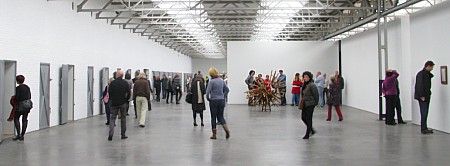
Ai Weiwei,
the artist, the philosopher and the rebel
Museum De Pont until june 24, 2012
Ai Weiwei (1957) is an artist, a philosopher and a rebel. It runs in the family. His father was a writer and a poet who was forced to live in exile in a labor camp for over 16 years. Ai Weiwei received his education in China and lived in the USA from 1981 to 1993. When his father became ill he returned to China. His art is multifacated and a challenge for our associative talents. He currently has a very inspiring show at Museum de Pont which is on view through 24 June.

Ai Weiwei’s art is about China, but his art is not the Chinese art that became popular during the late eighties and the nineties, with the cynical and caricatural paintings by for instance Fan Lijun and Yue Minjun, colorful paintings, crowded with bald headed, smiling, blunted figures. Ai Weiwei is not a painter, he has embraced the concept that art can be expressed in any way or form. In some of his videos he uses today’s reality in China as a ready-made, like Duchamp and Warhol before him, a registration of reality as it is, only ‘manipulated’ by the choice of subject.
Beijing is a 150 hour film of a 2400 km taxi drive, crossing a district of Beijing. The film shows a public space dominated by inanimate architecture, by motorways and cars, a view not different from any modern western city. The Chinese ornament hanging down from the cab’s rear mirror questions the scarce presence of remainders of traditional Chinese culture and architecture.
The Second Ring is a 66 minute film taken from the 33 bridges that cross the second ring in Beijing, 1 minute of film in each direction. It is an objective depiction of this fragment of reality without any explicit comment. The film leaves any questioning or commenting to us, to the viewer.
I’m not an analyst, my art is intuitive, of course I have put certain ideas into the works but they may not be the most important aspect. That is for other people to decide.
His art is Chinese, he acknowledges the skills, the craftsmanship of the Chinese cultural tradition, works of art from the past reflect as he puts it: the morality, the aesthetics and the philosophy of its time. He uses elements of this tradition and connects them to contemporary social-political issues, for instance by reconstructing trees as if museums are becoming the only save havens for conserving nature, just as they are for conserving important art. The Forever-bicycles sculpture integrates ready-mades into a carousel or is it a treadmill, it seems a metaphor for the absence of a strong believe in individuality in Chinese culture. And in his most famous work, the hundreds of thousands of painted sunflower seeds, Ai Weiwei suggests a modern form of slavery, a contemporary form in which the western 17/18th century Chine de Commande porcelain has been replaced by shirts, shorts and shoes.
Ai Weiwei’s Fountain of Light is a Chinese version of Tatlin’s Monument to the Third International, a symbol of modernity and a tribute to the Bolshewik Revolution of 1917. Weiwei’s monstrous sculpture addresses the audacity, the self-glorification of ideologies and the complete absence of any appropriate humility.
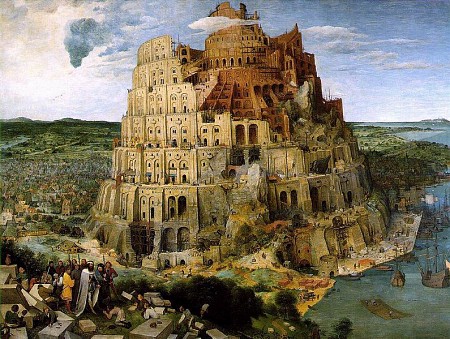
Pieter Breughel, Tower of Babel

Model of Tatlin’s Monument
Fountain of Light (at Museum De Pont)
Text & photos: Anton K.
De Pont museum of contemporary art:
Ai Weiwei until 24 June 2012
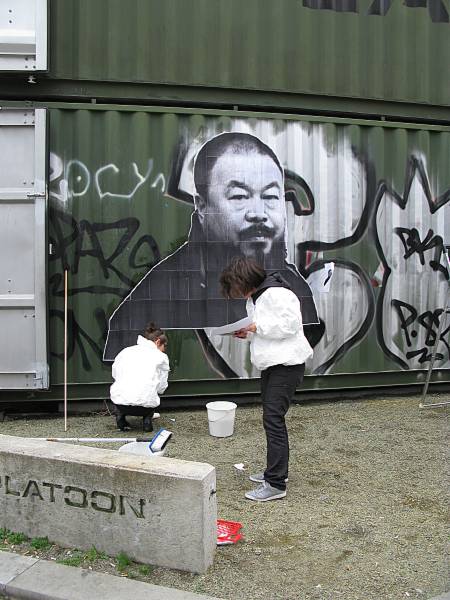
Berlin, Linienstrasse, protest against Ai Weiwei’s arrest, April 2011
fleursdumal.nl magazine
More in: Ai Weiwei, Anton K. Photos & Observations, Exhibition Archive, REPRESSION OF WRITERS, JOURNALISTS & ARTISTS, Sculpture
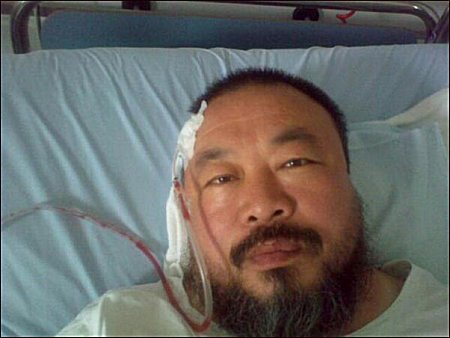
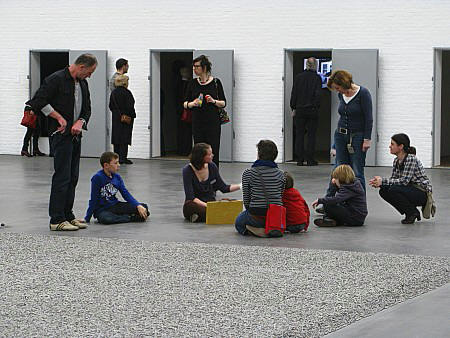
Museum De Pont Tilburg until June 24, 2012
artworks of Ai Weiwei
photos Anton K.
fleursdumal.nl magazine
More in: Ai Weiwei, Art & Literature News, Exhibition Archive
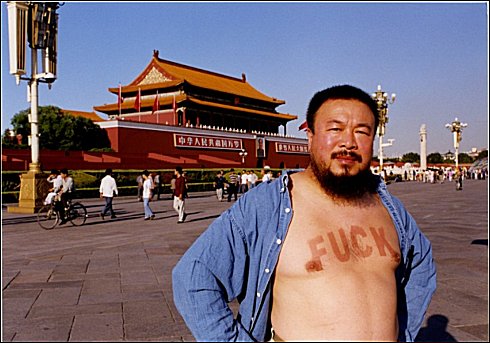
Ai Weiwei
Museum De Pont Tilburg
t/m 24 juni 2012
Geen Chinese kunstenaar is zo bekend als Ai Weiwei (Beijing, 1957). Die roem dankt hij niet alleen aan zijn kunst, maar ook aan zijn strijd voor meer politieke en maatschappelijke vrijheid. De expositie in De Pont toont werk uit de jaren 2003-2011 en omvat naast een aantal grote sculpturen, zijn bijna volledige videowerk.
Beeldend kunstenaar, architect en vormgever, curator, fervent gebruiker van sociale media en luis in de pels; Ai Weiwei’s opvatting van het kunstenaarschap is zeer breed. De sociale component van zijn werk roept herinneringen op aan het ‘erweiterter Kunstbegriff’ van Joseph Beuys. Zelf noemt hij Andy Warhol en Marcel Duchamp als belangrijke voorbeelden. ‘Tot ik Duchamp ontdekte had ik er geen idee van dat kunst een manier van leven kon zijn.’ zegt hij in een interview uit 2008 met Karen Smith. ‘Het was mijn redding en het maakte direct een eind aan mijn geworstel. Ik begreep […] dat kunst een gebaar kon zijn, en dat een gebaar iedere vorm kan krijgen die de kunstenaar wil. Dat kan een schilderij zijn maar ook iets totaal anders.’
Ai Weiwei ziet kunst als middel om veranderingen te forceren, als kans om nieuwe vragen te stellen en ruimte te scheppen voor nieuwe mogelijkheden. In het uit 2003 daterende Forever, het vroegste werk op de tentoonstelling, vormen 42 op- en aan elkaar gelaste fietsen radertjes in een carrousel. Los zouden ze niet kunnen functioneren: ze missen trappers en stuur. De installatie dankt zijn titel aan het op de frames aangebrachte merk van dit in China tot voor kort nog zo massaal gebruikte vervoermiddel. Behalve een commentaar op de sociale situatie in zijn land, houdt het werk ongetwijfeld ook een verwijzing in naar Duchamps beroemde readymade. Ook in zijn overige werk maakt Ai Weiwei veelvuldig gebruik van het principe van de readymade en eigent zich bestaande objecten toe. Niet alleen in dit opzicht, ook in zijn commentaar op de eigen culturele traditie treedt hij in de voetsporen van Duchamp. Daarin is hij rigoureus en hard. Nam Marcel Duchamp een reproductie van de Mona Lisa, Ai Weiwei maakt van echte kunstobjecten gebruik. In zijn bekende, uit 1995 daterende fotoserie Dropping a Han Dynasty Urn laat hij een eeuwenoude vaas stuk vallen en in Painted Vases (2006) doopt hij oeroude potten in fel gekleurde lakverf. In even simpele als onomkeerbare daden rekent hij af met de manier waarop in het heden en recente verleden is omgegaan met de eigen culturele traditie. In andere werken stelt hij de authenticiteit van die traditie zelf aan de orde. Om de weg te effenen voor het nieuwe moet je in zijn visie ook kunnen vernietigen, het oude uit de weg ruimen.
Net als Jeff Koons – maar met een totaal andere lading – schakelt Ai Weiwei getalenteerde ambachtslieden in voor de vervaardiging van zijn objecten. Zij hebben de traditionele houtverbindingen gemaakt, waarmee de verweerde stukken hout van kamferbomen zijn geassembleerd in de luguber ogende Trees (2009-2010). Zij leverden ook een tour de force met de grote, witporseleinen en blauwafgebieste Rocks (2009-2010), die als kunstmatige eilanden verspreid op de vloer liggen. In plaats van Chinoiseries realiseert Ai Weiwei met behulp van deze ‘typisch Chinese’ technieken vervreemdende en tegelijkertijd oogstrelende werken, die ingesleten noties over cultuur en de eraan toegekende waarden en betekenissen tarten.
De paradoxen die Ai Weiwei in zijn kunst aan het licht brengt, treden misschien wel het sterkst naar voren in zijn Sunflower Seeds. Het is het werk waarmee hij, toen hij het in 2010 voor het eerst toonde in de grote turbinehal van Tate Modern, beroemd werd bij het grote publiek en waarvan nu twee kleinere varianten in De Pont te zien zijn. De zonnepitten hebben meerdere betekenissen voor het Chinese volk. Ze dienen niet alleen als voedsel, maar hadden tijdens de culturele revolutie ook een symbolische lading. Nadat Mao Zedong zich de zon als persoonlijk symbool had toegeëigend, werd het Chinese volk vergeleken met zonnebloemen, die vol bewondering opkeken naar de grote roerganger. De duizenden zaden, die op de tentoonstelling versmelten tot een grijs tapijt, zijn echter van porselein. Dat gegeven roept nog een beeld op: dat van 1600 arbeiders in Jingdezhen, de porseleinhoofdstad van China, die een jaar lang elk van de 100-miljoen vormpjes van roomwit porselein in hun hand hebben genomen en er met een paar grijze penseellijntjes zonnebloempitten van hebben gemaakt.
In zijn video’s en de blog, waarop hij van 2006 tot 2009 talrijke teksten en foto’s heeft gepubliceerd, heeft Ai Weiwei zeer uiteenlopende kwesties op cultureel, politiek en maatschappelijk gebied aangeboord en misstanden aan de kaak gesteld. Zo zocht hij de grenzen op van wat het bewind aan kritiek kon verdragen. Sinds zijn hechtenis in de lente van 2011 is zijn actieradius ingeperkt en is het hem vooralsnog niet toegestaan om Bejing te verlaten.
Van 22-28 maart vindt in Den Haag het jaarlijkse Movies that Matter Festival plaats. Eén van de hoogtepunten van het festival is de Europese première van de nieuwe documentaire Ai Weiwei: Never Sorry over de befaamde Chinese kunstenaar en dissident Ai Weiwei.
fleursdumal.nl magazine
More in: Ai Weiwei, Exhibition Archive, REPRESSION OF WRITERS, JOURNALISTS & ARTISTS, Sculpture

Ai Weiwei: Interlacing
Until: 15th Jan. 2012
Kunsthaus Graz – Lendkai 1 – 8020 – Graz
The first large-scale exhibition of Ai Weiwei’s photographic and video work—taken over from the Fotomuseum Winterthur—puts the spotlight on Ai Weiwei the communicator and indefatigable remembrancer, the documenting, analysing, interlacing and multichannel-communicating artist. Even in his New York period (1983–1993), Ai Weiwei took photographs, but especially since his return to Beijing, he has tirelessly documented everyday realities of the urban environment and society in China, and discussed them in blogs and twitters. The photographs of the radical changes to the urban built fabric, the search for earthquake victims, and the destruction of his Shanghai studio are presented along with art-photographic projects, the documenta Fairytale project, the countless blog and mobile-phone photographs. The exhibition is accompanied by an extensive book of material and archives (published by Steidl, Göttingen).
Ai Weiwei is a generalistic, conceptual, socio-critical artist, dedicated to friction with and the design of realities. As an architect, conceptual artist, sculptor, photographer, blogger, Twitterer and interview artist and political activist, he is a seismograph for current themes and social problems: a great multiplicator and communicator, who leads a life for art and art as life.
Ai Weiwei was born in 1957, the son of poet Ai Qing. After studying at the Beijing Film Academy, in 1978 he and others founded The Stars artist collective, which rebelled against Socialistic Realism and came out in favour of artistic individuality and experimenting in art. In 1981, Ai Weiwei went to the USA, and in 1983 to New York, where he studied under painter Sean Scully at the Parsons School of Design. In New York, he discovered artists such as Allen Ginsberg, Jasper Johns, Andy Warhol and above all Marcel Duchamp. Duchamp was important to him because he saw art as a part of life. The result was his first ready-mades and thousands of photographs documenting his stay and those of his Chinese artist friends in New York. When his father fell ill, Ai Weiwei returned to Beijing in 1993. In 1997, he co-founded the China Art Archives and Warehouse (CAAW) and began to take an interest in architecture. In 1999, he opened a studio of his own in Caochangdi, and in 2003 founded the FAKE Design architecture studio. The same year, he was substantially involved with Swiss architects Herzog & de Meuron in the construction of the Olympic Stadium, the so-called Bird’s Nest, which after its completion became the new emblem of Beijing. In 2007, at his prompting, 1001 Chinese travelled to Kassel for documenta 12 (Fairytale). In 2010, he astonished the world with his large, formally Minimalist-arranged carpet at the Tate Modern, made of millions of sunflower seeds made of hand-painted porcelain.
At all times, every society in this world, in the past, present and future, needs singular, outstanding figures such as Ai Weiwei in order to remain alert and be shaken into wakefulness, to recognise its own rigidity and to avoid its own tunnel vision. We are delighted that this great thinker, designer and warrior was released from arrest on 22nd June 2011.
The exhibition was organised by the Fotomuseum Winterthur. Curator: Urs Stahel. From 21st Feb. to 29th April 2012, it will be on show at the Jeu de Paume in Paris.
fleursdumal.nl magazine
More in: Ai Weiwei, Andy Warhol, Exhibition Archive, REPRESSION OF WRITERS, JOURNALISTS & ARTISTS
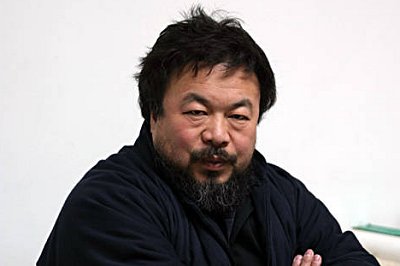
Ai Weiwei op borgtocht vrij
Gisteren werd bekend dat kunstenaar en activist Ai Weiwei door de Chinese regering op borgtocht is vrijgelaten. Amnesty International roept op om het internationale protest tegen de vervolging van Chinese activisten door deze vrijlating niet te temperen.
Ai Weiwei werd sinds 3 april van dit jaar zonder formele aanklacht vastgehouden. Volgens de Chinese staatsmedia is hij vrijgelaten vanwege ‘het bekennen van zijn daden en door een chronische ziekte waar hij aan lijdt’.
Amnesty International meent dat Weiwei’s vrijlating slechts symbolische tactiek van de regering is om te ontkomen aan de toenemende kritiek. Weiwei’s vrijlating valt namelijk samen met het staatsbezoek van premier Wen Jiabao aan het Verenigd Koninkrijk en Duitsland, landen waar Weiwei veel publieke steun geniet.
Amnesty roept de Chinese autoriteiten op om vier zakenpartners van Ai Weiwei die nog in geheime detentie vastzitten, onmiddellijk vrij te laten. Bovendien moet Ai Weiwei volledige vrijheid te krijgen. Hij mag niet onder onrechtmatig huisarrest geplaatst worden, zoals vaak na vrijlatingen van Chinese activisten gebeurt.
Ai Weiwei is een van de 130 activisten, advocaten, bloggers en tweeters die sinds afgelopen februari worden vastgehouden uit angst voor een Chinese Jasmijnrevolutie, zoals in het Midden-Oosten en Noord-Afrika.
Bron: Amnesty International
23 juni 2011
fleursdumal.nl magazine
More in: Ai Weiwei, Exhibition Archive, REPRESSION OF WRITERS, JOURNALISTS & ARTISTS
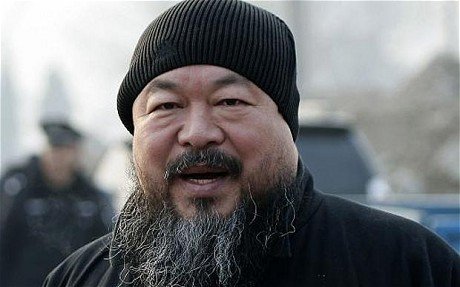
AI WEIWEI in DE PONT
i.s.m. het Louisiana Museum, Denemarken
De tentoonstelling van Ai Weiwei die Museum De Pont in Tilburg voor het voorjaar van 2012 gepland heeft, wordt georganiseerd in nauwe samenwerking met het Louisiana museum in Humlebaek, Denemarken (18 november 2011-12 februari 2012). De voorbereiding wordt inmiddels ernstig belemmerd doordat de kunstenaar is vastgezet door de Chinese autoriteiten en er geen enkel contact met hem mogelijk is. In samenspraak met de collega’s in Denemarken en enkele van Weiwei’s assistenten die in het Westen verblijven is besloten de tentoonstelling toch doorgang te laten vinden, er van uitgaande dat het juist nu belangrijk is zijn werk onder de aandacht te (blijven) brengen.
Ai Weiwei is op 3 april 2011 gearresteerd. Teken de petitie waarmee de vrijlating van Ai Weiwei wordt gevraagd: TEKEN PETITIE VRIJLATING AI WEIWEI
fleursdumal.nl magazine
More in: Ai Weiwei, Exhibition Archive, REPRESSION OF WRITERS, JOURNALISTS & ARTISTS
Thank you for reading Fleurs du Mal - magazine for art & literature